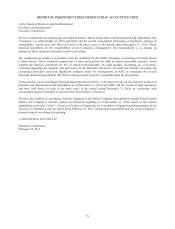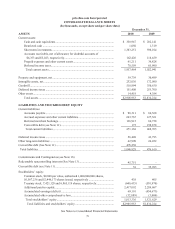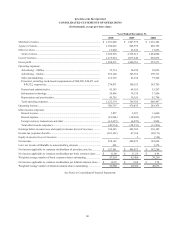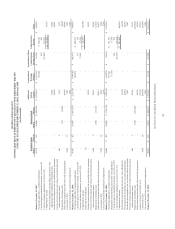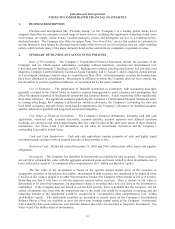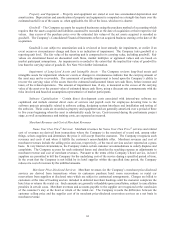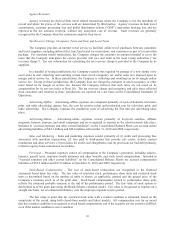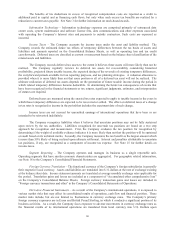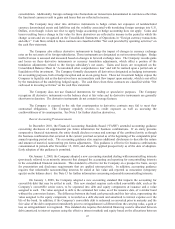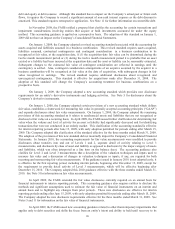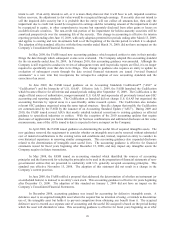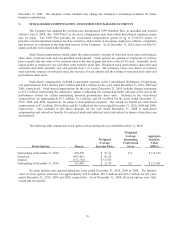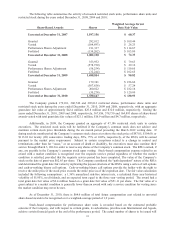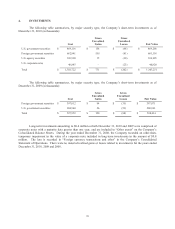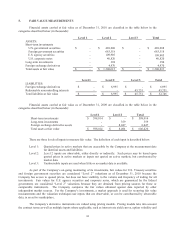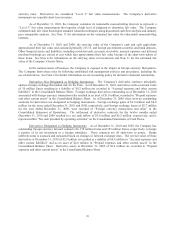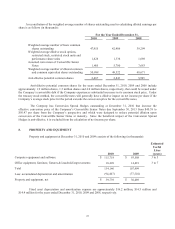Priceline 2010 Annual Report Download - page 161
Download and view the complete annual report
Please find page 161 of the 2010 Priceline annual report below. You can navigate through the pages in the report by either clicking on the pages listed below, or by using the keyword search tool below to find specific information within the annual report.87
consolidation. Additionally, foreign exchange rate fluctuations on transactions denominated in currencies other than
the functional currency result in gains and losses that are reflected in income.
The Company may enter into derivative instruments to hedge certain net exposures of nonfunctional
currency denominated assets and liabilities and the volatility associated with translating foreign earnings into U.S.
Dollars, even though it does not elect to apply hedge accounting or hedge accounting does not apply. Gains and
losses resulting from a change in fair value for these derivatives are reflected in income in the period in which the
change occurs and are recognized on the Consolidated Statements of Operations in “Foreign currency transactions
and other.” Cash flows related to these contracts are classified within “Net cash provided by operating activities” on
the cash flow statement.
The Company also utilizes derivative instruments to hedge the impact of changes in currency exchange
rates on the net assets of its foreign subsidiaries. These instruments are designated as net investment hedges. Hedge
ineffectiveness is assessed and measured based on changes in forward exchange rates. The Company records gains
and losses on these derivative instruments as currency translation adjustments, which offset a portion of the
translation adjustments related to the foreign subsidiary’s net assets. Gains and losses are recognized on the
Consolidated Balance Sheet in “Accumulated other comprehensive loss” and will be realized upon a partial sale or
liquidation of the investment. The Company formally documents all derivatives designated as hedging instruments
for accounting purposes, both at hedge inception and on an on-going basis. These net investment hedges expose the
Company to liquidity risk as the derivatives have an immediate cash flow impact upon maturity, which is not offset
by the translation of the underlying hedged equity. The cash flows from these contracts are classified within “Net
cash used in investing activities” on the cash flow statement.
The Company does not use financial instruments for trading or speculative purposes. The Company
recognizes all derivative instruments on the balance sheet at fair value and its derivative instruments are generally
short-term in duration. The derivative instruments do not contain leverage features.
The Company is exposed to the risk that counterparties to derivative contracts may fail to meet their
contractual obligations. The Company regularly reviews its credit exposure as well as assessing the
creditworthiness of its counterparties. See Note 5 for further detail on derivatives.
Recent Accounting Pronouncements
In December 2010, the Financial Accounting Standards Board (“FASB”) amended accounting guidance
concerning disclosure of supplemental pro forma information for business combinations. If an entity presents
comparative financial statements, the entity should disclose revenue and earnings of the combined entity as though
the business combination that occurred in the current year had occurred as of the beginning of the comparable prior
annual reporting period only. The accounting guidance also requires additional disclosures to describe the nature
and amount of material, nonrecurring pro forma adjustments. This guidance is effective for business combinations
consummated in periods after December 15, 2010, and should be applied prospectively as of the date of adoption.
Early adoption of this guidance is permitted.
On January 1, 2009, the Company adopted a new accounting standard dealing with noncontrolling interests
(previously referred to as minority interests) that changed the accounting and reporting for noncontrolling interests
in the consolidated financial statements. This standard is effective for the Company on a prospective basis, except
for presentation and disclosure requirements that are applied retrospectively. In addition, accounting guidance
requires that redeemable noncontrolling interests be stated at fair value and reported as mezzanine (temporary
equity) on the balance sheet. See Note 13 for further information concerning redeemable noncontrolling interests.
On January 1, 2009, the Company adopted a new accounting standard that impacts the accounting for
convertible debt that may be settled in cash. This new standard requires cash settled convertible debt, such as the
Company’s convertible senior notes, to be separated into debt and equity components at issuance and a value
assigned to each. The value assigned to debt is the estimated fair value, as of the issuance date, of a similar bond
without the conversion feature. The difference between the bond cash proceeds and this fair value, representing the
value assigned to the equity component, is recorded as a debt discount and amortized to interest expense over the
life of the bond. In addition, if the Company’s convertible debt is redeemed or converted prior to maturity and the
fair value of the debt component immediately prior to extinguishment is different from the carrying value, a gain or
loss on extinguishment is recognized. This standard also requires that deferred financing costs be allocated between
debt (amortized to interest expense using the effective interest method) and equity based on the allocations between



